Utilizing strategies often attributed to social scientists, Alison Ruttan investigates characteristics of human behavior through insightful works that reveal our propensity with aggression which is evolving at an alarmingly escalating pace. Recently, The COMP Magazine visited Ruttan at her Oak Park studio to discuss her exploratory use of varied media and research methods, her role as an educator, what she values most in her aesthetic practice, and what projects are currently under development.
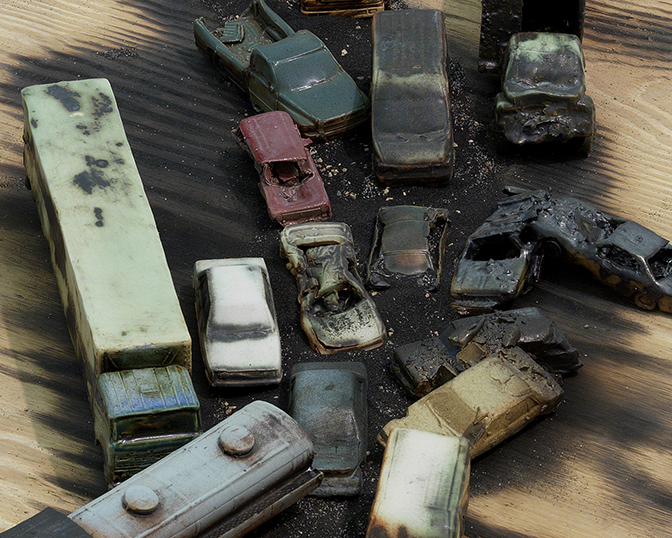
Alison Ruttan, “Line in the Sand” (detail), 2015
Slip Cast Ceramics, wood, burnt wood, sand, black sand
You’ve maintained a serious art practice for more than 20 years. Can we backtrack a bit and discuss your personal history? Perhaps, you can share with us some information on what or who piqued your interest to pursue a career in the visual arts?
I lived in many parts of this country and overseas growing up. My father was an Agricultural Economist who worked with 3rd world counties trying to figure out how best to spend limited resources. The world around us and our place in it was a constant conversation in the family I grew up in. I was born in Tennessee, then moved to Indiana, California, Washington DC, the Philippine Islands, Minnesota, New Mexico, Michigan, New York City and finally Illinois.
One of the consequences of moving so often is I became adept at re-presenting myself. Whatever didn’t work last time could be left behind and a new start could be had. I became accustomed to change as a comfortable space to be. Throughout this Art was a constant for me, it was a companion to me and gave me a strong sense of Identity. As an adult I learned to build change into my life as an Artist, if location couldn’t be changed, it could be built into the nature of my practice. I am engaged by new problems and learning but focus conceptually on the internal conversation I have with myself about the nature of the world I live in.
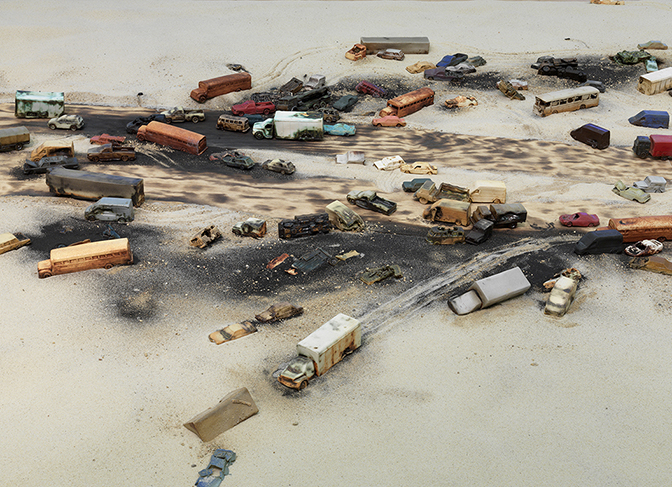
Alison Ruttan, “Line in the Sand” (close up), 2015
Slip Cast Ceramics, wood, burnt wood, sand, black sand
Using a wide range of media and research methods, you frequently focus upon complex issues that investigate human (and primate) behavior and the consequences of our actions. Specifically, in a number of series the issue of aggression appears to be central. I’m curious to what prompted you to focus upon this aspect of behavior?
I am drawn to investigating what I do not understand. That is usually a starting point in all my projects. Moral and psychological dilemmas interest me, particularly those that seem impossible to resolve. Perhaps the biggest question for me has always been “Why do humans behave the way they do?”, If I wasn’t an artist I am sure I would have been an evolutionary psychologist.
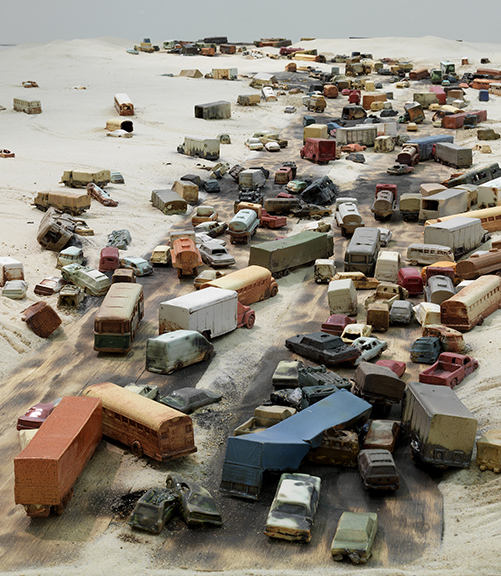
Alison Ruttan, “Line in the Sand” (close up), 2015
Slip Cast Ceramics, wood, burnt wood, sand, black sand
New projects emerge out of personal observations, readings, conversations and my own speculations. Eventually these connect with materials, forms and images. I draw from a wide range of sources and tend to view this material in a non-hierarchical way.
While research is an important part of my practice I do not regard it as fixed path within the subject. To be fully inside a project is to understand that the subject is in a continual state of being reshaped by the very process of making the work. The coming together of concept and craft breeds invention.
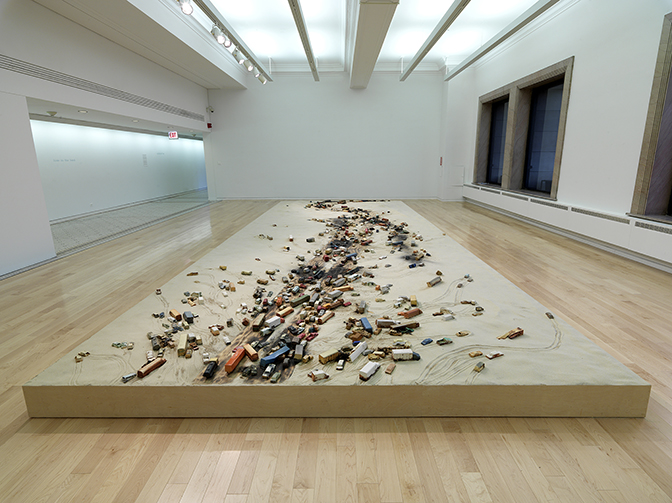
Alison Ruttan, “Line in the Sand” (installation view), 2015
Slip Cast Ceramics, wood, burnt wood, sand, black sand
In my art practice, I am usually attempting to understand behavior that is beyond my own experience. This is probably rooted in a combination of my experience growing up in so many different communities, but also coming of age in the early 1970’s where sexual politics was radically redefining the roles men and women could choose for themselves. As a young women, my political awakening started with the realization that my smaller size made me potentially vulnerable to male rage, that the equality I sought could be undermined by my biology. Later, I would realize that being male was not so easy either, hierarchical positioning and posturing is a constant within many male relationships. I remember being told in my teens that women would not make good leaders because we were too emotional and couldn’t be counted on to make rational decisions. That seemed completely ridiculous to me because it was clear to me that men were not either. (This false assumption on male rationality is something I have thought of frequently in recent work that looks at war.) As I got older I became interested in the way both culture and biology act on us in shaping our behavior. Early work investigated instinct as it related to sexual appetite but this shifted after 9/11 to questions regarding aggression and war. “How much of our behavior is rooted in the core of our biological identity and how captive are we to these impulses?” continued to drive many of the questions I explored in my art.
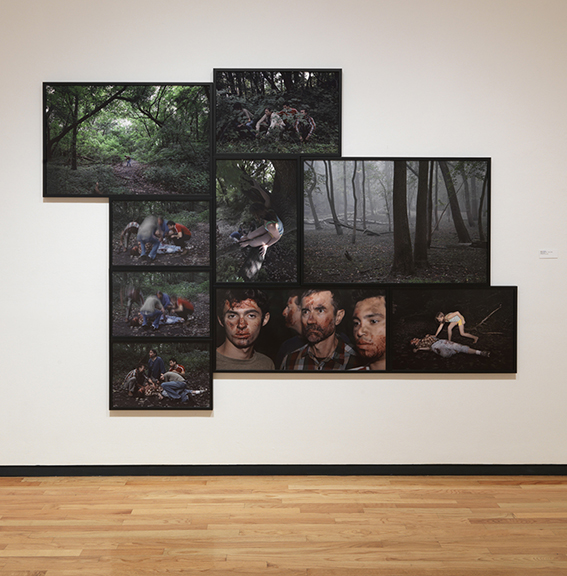
Alison Ruttan, Sequence ”The end comes for Willy Wally” from the Series “The Four Year War at Gombe”, 2014
multiple sized photographs
Later I became interested in trying to better understand who we are by studying primates, who are our closest biological relatives. Bonobo’s. Chimpanzees, Orangutans and humans are all newer primates, we all descended from a common ancestor. Traits that we share between us are old and deeply embedded in our behavior, even today. Many projects emerged from this research, some funny and others serious. More recently I have looked at the cyclical nature of war beginning with the photographic series titled “The Four Year War at Gombe” which was scripted from a portion of Jane Goodall’s research that examine the origins of violence in warring Chimpanzee communities. For me, reading these accounts was like looking at an origin story of ourselves, the patterns of violence she described could have been drawn from the Bible as in the story of “Cain and Able” or one of Shakespeare’s tales of intrigue, corruption and power. The ape projects eventually brought me back to our own wars and in particular the present ones in the Middle East, of which there seems to be no end. This time I am asking?” “Can we evolve out of endless cycles of war and conflict?” Is this truly “our Nature?” In the last 5 years I have been working on projects in ceramics that follow the spreading conflicts in the Middle East, specifically the damage communities have suffered. I am making a case through this work, that logic aside, one only has to “look” at the evidence of destruction to see that it is wrong, regardless of either sides contributing actions.
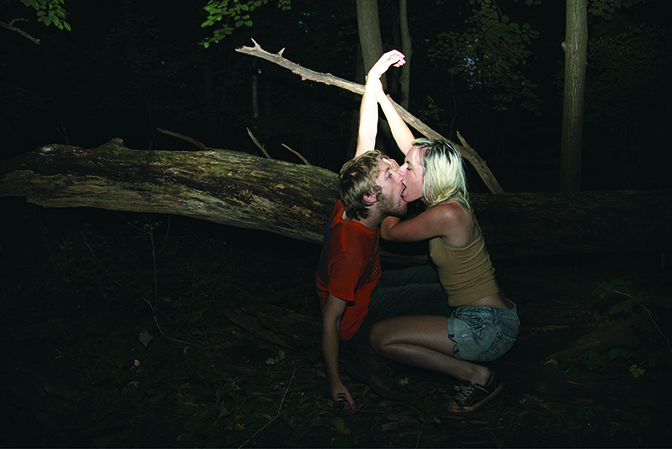
Alison Ruttan, “Gigi Kissing Mustard” from the Series “The Four Year War at Gombe”, 36” x 45”, 2014
I find your varied use of materials interesting. You were initially trained as a photographer, I believe? However, you appear to select a medium specific to the content (e.g., the use of ceramic for the series Beirut, 2013-2015, and Syria, 2015) you are addressing. Can you discuss how the conceptual approach and research informs your tactile process?
My practice has never been medium specific, that would feel to restrictive to me, but I do consider myself to be materially invested. Medium and and style are seen as contextual choices that set the tenor that I intend to use to draw interest to my subject.
I often reference other artists and movements as a way of bringing the past into conversation with the present. It is also a means of progressing a story line when your working with a compressed experience (as opposed to a book or a movie). In “The four-year war at Gombe” it enabled me to tell a non-human story in ways that encouraged viewers to find familiarity within an ape story. The beginning of the series makes reference to the idyllic landscapes of Camille Corot as well as American Communal Life of the 1960’s. It moves from there to foreboding scenes, suggestive of the lush imagery seen in Pre-Raphaelite painting’s, this is mixed with a strangeness that is more akin to the photographs of Diane Arbus and Weegee. As the story progresses into the series of murders that Goodall wrote about, the references begin to feel more filmic. Movies like Deliverance, West Side Story, The Last of the Mohicans and the Lord of the Fly’s might be picked up on. In the more recent work in ceramics a cooler minimalist aesthetic is butted up against content that is horrific and emotional. This pairing was meant to draw attention to the contradictions that we face within ourselves when we look with detached curiosity at such scenes but are also confronted with the reality of what we are seeing. The series “Line in the Sand” was designed to appear abstract from afar, almost like brush markings, but would reveal itself upon closer inspection to be something entirely different. This can also be seen metaphorically as relating to continued disinformation on this military action from the Gulf War.
I believe that the questions I am asking will be perceived most honestly if the medium and style of representation are as carefully chosen as the subject I am investigating. I also believe that working through the medium alters and informs the subjects in ways that ultimately bring more depth to the work. Because I work this way it is a given that each new project will involve a learning curve.
So, “why did I shift to ceramics”, after all I had no background in it prior to 2011. I had a sense that even though most of my work was in photography and video the emotional center of what I was after had to be something physical. The materiality of objects has a presence very different from photographs or video, the tactility of objects seemed like it would enhance the possibilities for empathy. I felt that we are already too immune to the media images that pour into our homes on our television sets and laptops. Ceramics, more than any other material had an honesty within the material itself that would require little “illustrating”. It breaks in very much the same way as the collapsed cement buildings we see on the news. The torturing of the clay through fire seemed apropos too.
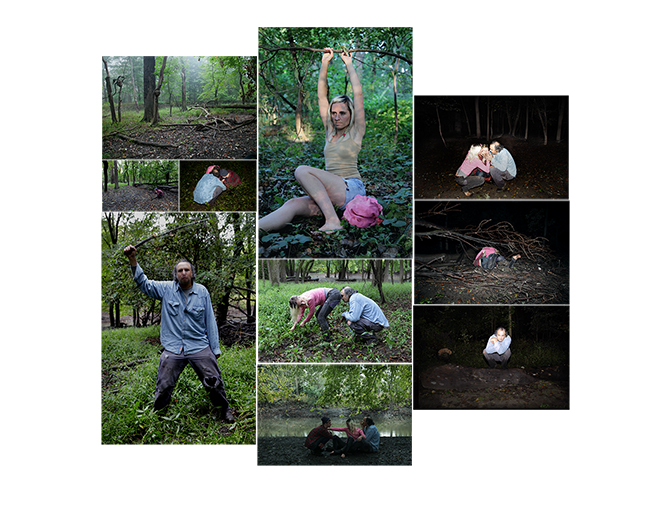
Alison Ruttan, Sequence “Deans Death” from the Series “The Four Year War at Gombe”, 2014, multiple sized photographs
You have been teaching in the city since the early 1990s. Having taught at Columbia College Chicago, the University of Chicago (U. of C.) and the School of the Art Institute (SAIC), do you see any specific recurring items that you have regularly share with your students throughout your tenure as an educator?
I am most interested in helping my students work with the questions unique to their own experiences in the world. I try to teach that an art practice can become a tool that is used to better understand the world and the how we fit into it. It allows you to be inside the subject looking at it from multiple angles and edges. For me that opens up my subject in ways that enable me to examine and cultivate my own perceptions. Ideas that are contained in objects must be interpreted, they do not speak themselves. Their meaning always lies somewhere in the space between the artist and the viewer. In this way it can be like a conversation, the best art work for me are always ones that do not complete my thinking, that leave something unsettled for me to ponder.
There is a lot of pressure on students to make art that “matters”, that can point to direct outcomes. I am not sure art is very good at that. I try to get students to see that what they do, does matter collectively. Change is like a wave, it happens when ideas begin coalescing, the, arts, literature, film, fashion, journalism pundits etc.…. all of us build it. It is rare that an individual work can be credited with singular momentous change, even though we may later make a symbol of an image, object, writing or event that seems to represent this pivotal point. I try to help student see that there are many ways to contribute, that they must look at what is in themselves and that their integrity as an artist will depend on their ability to be critical of their own thinking.
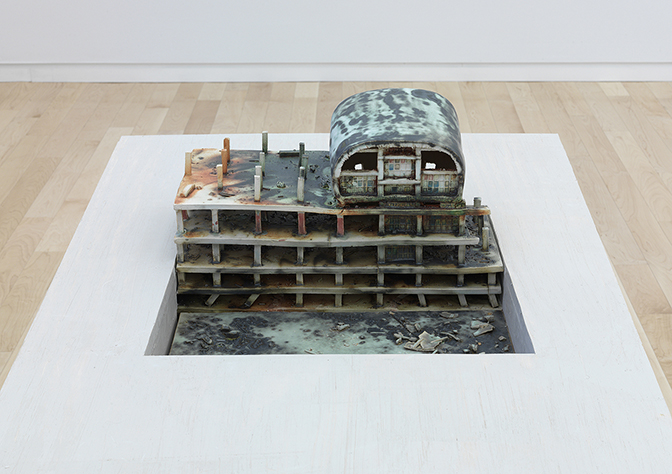
Alison Ruttan, “The Egg”, 18” x 9” x12”, 2015, Ceramic Sculpture
What do you value most in your aesthetic practice?
Looking is a different way of knowing than verbally expressing one self. For any artist you must think within the language of form, material and contextual relationships. Aesthetic choices are a complex set of decisions that are intellectually demanding, which is why I take them seriously. There is considerable engagement in thinking about each move you make in a work, critically considering how it contributes to the whole. In my work I am often trying to straddle a place between the abstract and the real. If it is too realistic or too detailed the viewer gets too involved in admiring the craftsmanship, as if that it the main part of the experience rather than the subject. If it is too abstract the connection to the source material is again lessoned, becoming merely referential. At the same time using parts of these attributes helps to diffuse the subject, which is very sad. You might wonder why I would want to do that. I want the work to engage on multiple levels and for it to do that there must be breathing space. The process of understanding what you are looking at must be slowed down. One way of doing that is make work that is about more than the obvious. I try to have multiple conversations with my work that offer tangents for my viewers to consider.
Making the work interesting to look at is a good starting point, I love that people bend over in an intimate contact with the work, examining the surfaces, looking in the windows as they consider where the people have gone. It is equally impossible to ignore how strange and interesting these images of destroyed cities are. The vast majority of the bombed buildings we see in the news belong to an “International Style” of architecture found in almost any modern city in the world. Modernity’s presence is easily seen in the gridded structures revealed by the destruction as well as the directional movements within the collapses themselves. An awareness of an aesthetic, an aesthetic associated with art is part of what makes this work both compelling and uncomfortable. It is also possible to think about this work in terms of a failure in modernism, a failure to transform the Middle East into an image of ourselves. It is similar with the large installation of 563 cast ceramic vehicles, “Line in the Sand”, 2015 that referenced the notorious “Highway of Death” from the Gulf War,1991. It is my hope that the work creates a nuanced encounter with subjects that haunts our consciousness.
* “A bad Idea seems good Again”, “Line in the Sand’ and “the Four Year War at Gombe” were shown together under the title “If all you have is a hammer everything looks like a nail” at The Chicago Cultural Center in 2015.
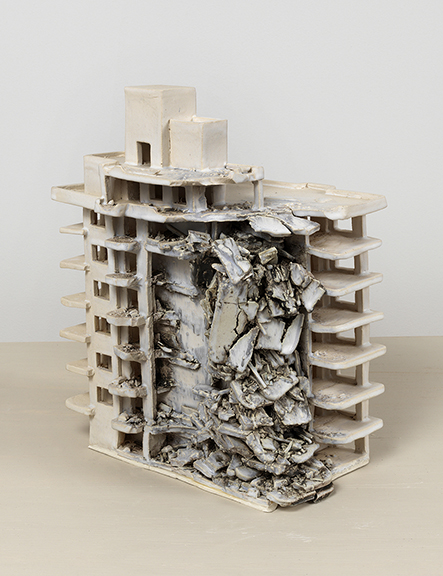
Alison Ruttan, “Quarter Collapse”, 10” x 12” x 17”, 2014, Ceramic Sculpture
You are currently on sabbatical. I believe you mentioned that you plan to travel to China? I’m wandering if this trip will include a research element? Do you plan to expand your investigations to include a component on the Far East?
My ceramic sculpture scale and the degree of description/detail I use were modeled on Funerary Models from the Han Dynasty, which have a simplicity that is still very specific. The Chicago Art Institute has several of them. I am very exited to look at more of these and other craft forms, architecture and landscape on this trip. It is also an opportunity to surprise myself. I am taking a Mandarin class in preparation.
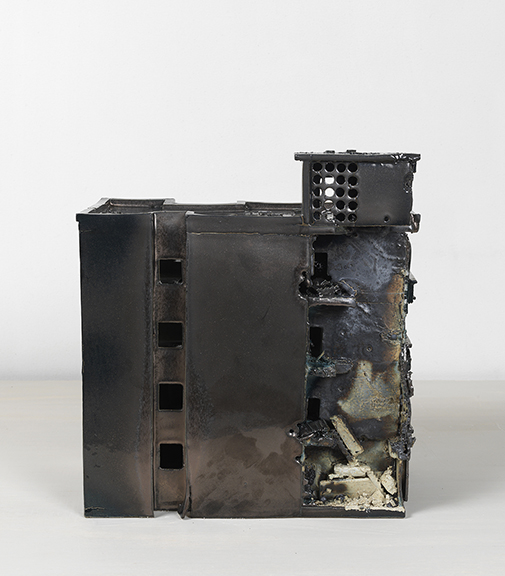
Alison Ruttan, “Gun Metal 2”, 12.25” x 8.5” x 15”, 2016, Ceramic Sculpture
What are you currently working upon? Do you have any upcoming exhibitions or ongoing projects in process you can share?
I am almost finished with a series of 12 black ceramic buildings based on documentation of the destruction of Aleppo in Syria. There is also a side project that combines sculptural forms and text that’s just about to go into the kiln. I have just begun another highly involved project that may have up to 50 buildings. I have been watching drone footage and news images that document large swaths of city blocks that have been destroyed in Aleppo and Homs. In this project I want to focus more on the scale of the disaster than the individual buildings. These buildings are much more skeletal and sketchy in feel. I expect this to be a project that will take up much of my time in the next year.
The black series will be shown in part at Dominican University in November, Additional work from these series will be shown at The Ukrainian Art Center, and curated by Victoria Fuller next summer. I am working with Barbara Koenen, has organized a project called “E Pluribus”, an informal collective of artists who are offering exhibitions and related programming to organizations that are working with people most impacted by the attacks in recent conflicts – refugees, veterans, aid workers and their families.
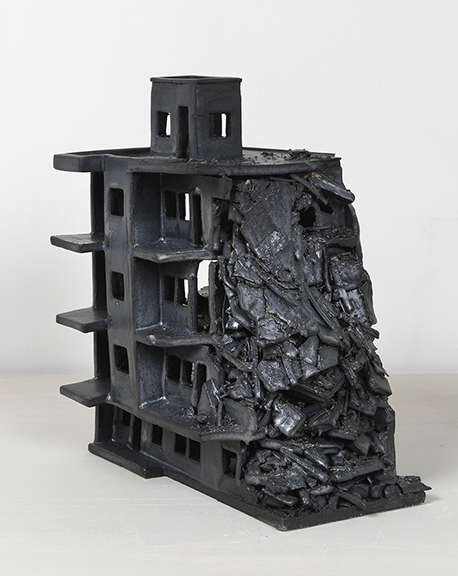
Alison Ruttan, “Gun Metal 3”, 12.25” x 8” x 13”, 2016, Ceramic Sculpture
For additional information on the art and practice of Alison Ruttan, please visit:
Alison Ruttan – http://www.alisonruttan.com/
Chicago Tonight – http://chicagotonight.wttw.com/2014/11/06/artist-alison-ruttan-creates-destruction
Newcity Art – http://art.newcity.com/2015/03/09/portrait-of-the-artist-alison-ruttan/
Chicago Cultural Center – http://www.cityofchicago.org/city/en/depts/dca/supp_info/ruttan.html
Museum of Contemporary Photography – http://www.mocp.org/collection/mpp/ruttan_alison.php
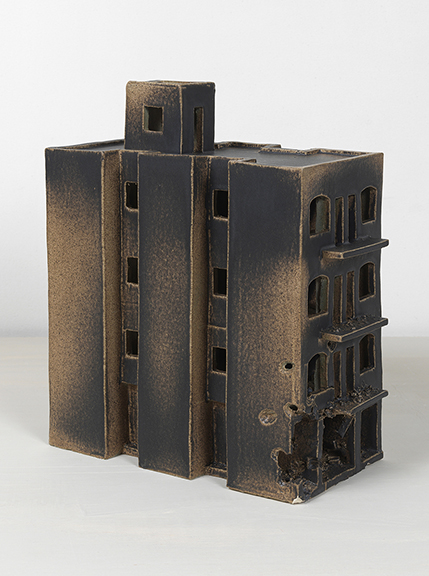
Alison Ruttan, “Black Ash”, 6.25” x 8.5” x 15”, 2016, Ceramic Sculpture
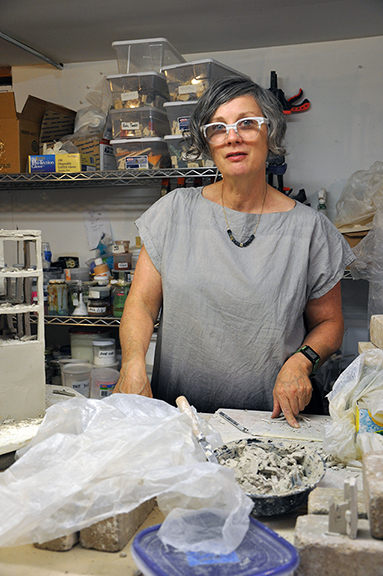
Alison Ruttan, artist, Oak Park, Illinois, 2016
Artist interview and portrait by Chester Alamo-Costello


